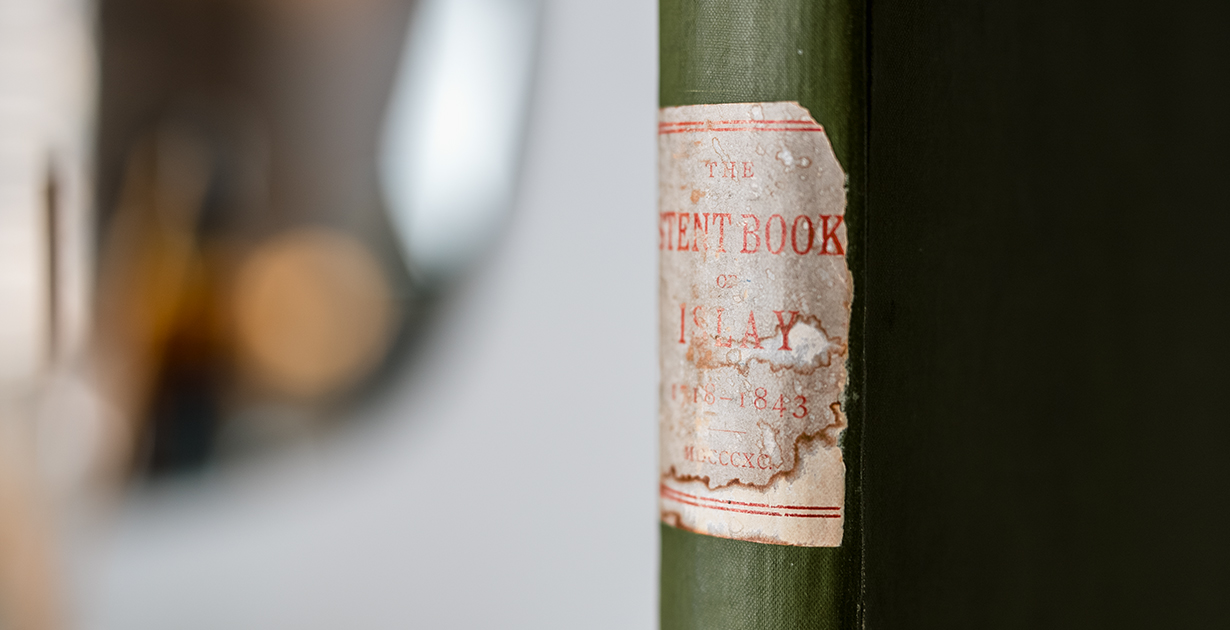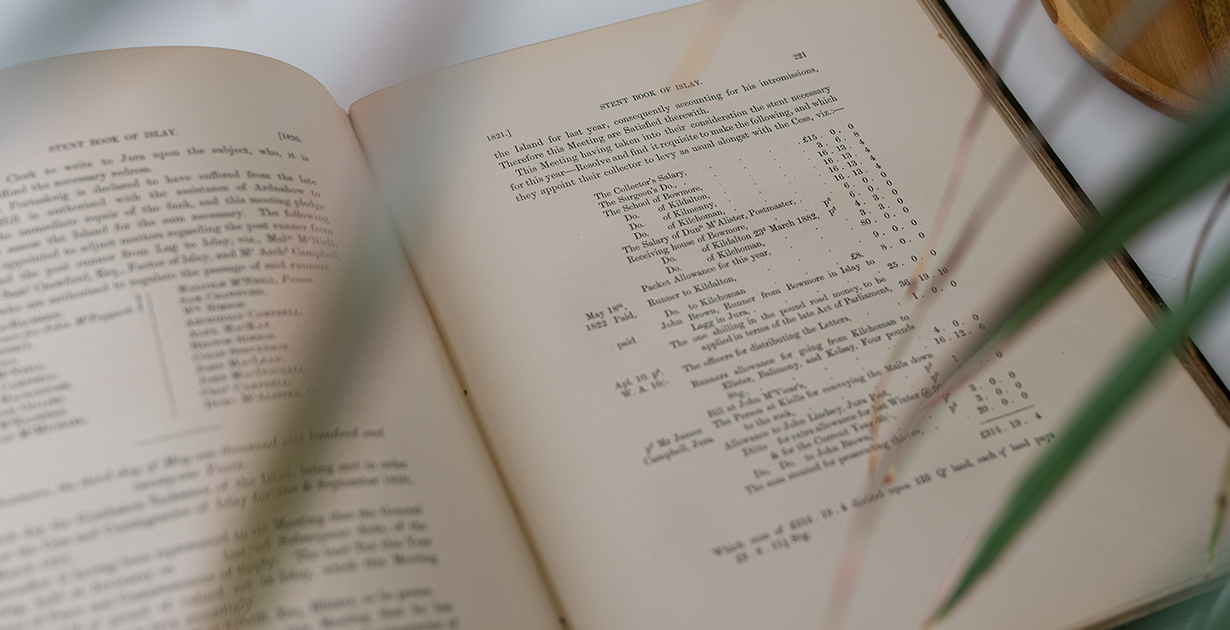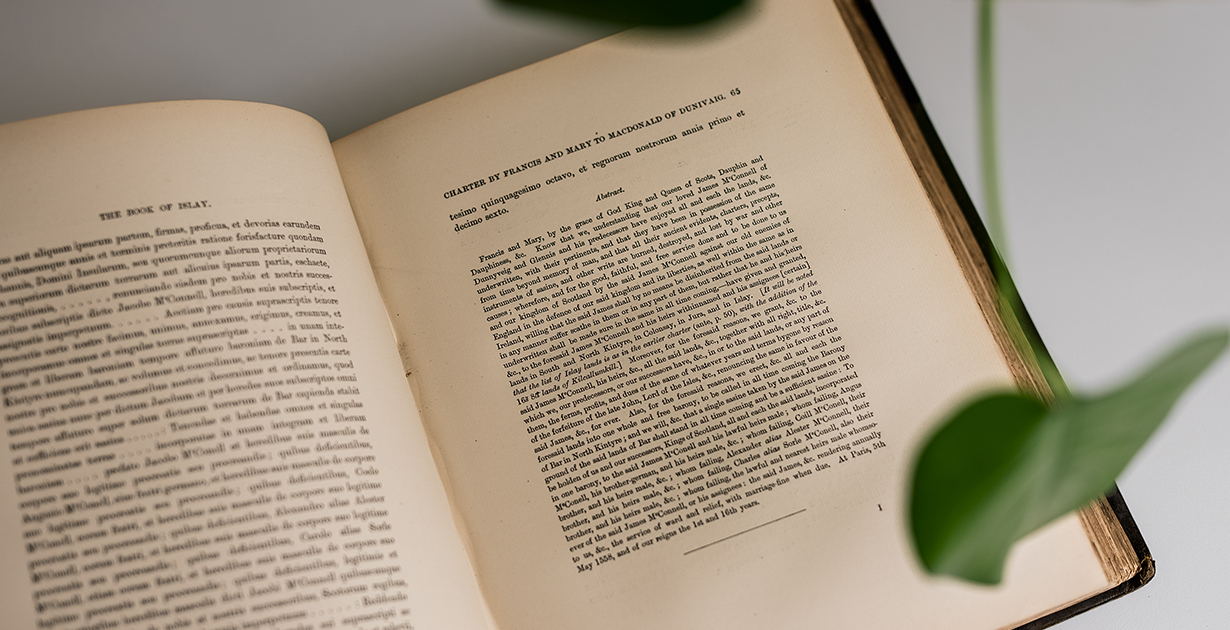
In the modern day, Islay is essentially a byword for peated whisky. The island, located on the Outer Hebrides, is famous for its smoky single malt scotch from distilleries such as Ardbeg, Bowmore, and Laphroaig.
However, the history of the island itself, apart from its standing in the whisky industry, is equally as fascinating as its single malt success.
The Book of Islay and The Stent Book and Acts of the Balliary of Islay: 1718-1843 provide a fascinating and in-depth account of the history of the island. Printed in 1895 and featuring gold page-edge gilding, this rare two-volume collection is one of only 250 privately printed paired copies.
The Book of Islay contains legal, ecclesiastical, and statistical documents illustrating the history of the island from 498 AD to 1752.
The Stent Book of Islay evidences Islay’s administration and development between 1718 and 1843, containing the annual meeting records of the island’s ‘Local Parliament’.
John Ramsay and the Kildalton Collection
The foundation of these two volumes was the Kildalton Collection of historical documents, acquired by John and Lucy Ramsay. John Ramsay of Kildalton was a prominent figure on Islay. His career spanned roles as a distiller, merchant, and Liberal politician that led to him having a significant impact on the island’s infrastructure and whisky industry.
In 1836 John Ramsay obtained the lease to the Port Ellen distillery. Following this acquisition, he pioneered the transatlantic whisky trade by exporting to the United States from the newly improved dock facilities at Port Ellen in 1881.
The island’s burgeoning whisky industry and infrastructure were also aided by Ramsay’s creation of a bi-weekly ferry service between the island and Glasgow. This in turn established Port Ellen as the island’s main ferry terminal.
John Ramsay also established a long-term business partnership with Walter Frederick Campbell, the landowner laird of Islay. The partnership secured the Port Ellen distillery lease and created Islay’s ferry service. The Book of Islay’s preface suggests that Ramsay entered into possession of the Kildalton Collection by acquiring the historical documents alongside much of the Kildalton parish lands from Campbell.
In 1871, John Ramsay married Lucy Martin, an antiquarian enthusiast who would subsequently act as the primary editor of the Kildalton documents. Her edits would later comprise the two volumes that comprise this History of Islay collection.
The Stent Book and Acts of the Balliary of Islay: 1718-1843 (1890)

The Stent Book of Islay provides an account of the island’s domestic administration. It was edited by Lucy Ramsay and released in 1890.
The passage of the Local Government (Scotland) Act in 1889 established elected county councils across Scotland to replace the independent local administrations. Prior to this, the island’s insular district managed and governed local affairs for over a century via an annual meeting of the ‘Local Parliament’.
Records of Islay’s Local Parliament commenced in 1718, when Islay was in the possession of the Campbells of Calder, who had received the lairdship from the Scottish Crown in 1621.
Islay’s Local Parliament convened a meeting of the ‘Gentlemen of Islay’ (prominent landowners, farmers, and merchants) annually. The minutes and financial accounts of these meetings were recorded in the Parliament’s ‘Stent Book’. In 1843, the annual meeting of the Local Parliament abruptly ceased.
The earliest Stent Book accounts are from 1718 and they record the use of taxes collected, including rent to the Crown. In addition, the book also recorded the salaries of the island’s surgeon, schoolmaster, and tax collectors.
By the final records of 1843, the Stent Book records the salaries of multiple surgeons and schoolmasters, a midwife, and the costs of the maintenance of the sheep pens at Port Askaig.
Investment and improvement in Islay’s infrastructure as the population expanded is a regular feature in the Stent Book records. Insights range from the building costs for schoolhouses and post offices to the maintenance of roads and port facilities.
Islay’s whisky heritage is evidenced by records showing that the Local Parliament resolved to prevent the actions of illegal distillers in 1801 and to restrict the ferrymen’s allowance of whisky for transporting cattle in 1818. Accounts also record the amount spent by the assembly on alcohol for these annual meetings.
The Book of Islay (1895)

After John Ramsay passed away in 1892, Lucy Ramsay approached G. Gregory Smith to collate a chronological volume of documents relating to historical Islay.
The Book of Islay was the result. It was completed in 1895 and drew on sources such as the General Register House in Edinburgh, the London and Dublin Record Offices, and private collections including those of Cawdor Castle, Lambeth Palace, the Vatican, and the Duke of Argyll.
The Book of Islay collects a range of historical, ecclesiastical, and statistical documents illustrating the history of Islay, complete with translations. The earliest document in the book is an account of Gaelic settlers dating from 498AD, while the latest, an Instrument of Sasine, records lands bestowed on Colin Campbell in 1752.
For editor G. Gregory Smith, the Book of Islay chronicles the ‘romantic period’ of the isalnd’s history covering events including a tribute to Norwegian Kings, the period of rule under the Lords of the Isles, and Clan Campbell’s appointment to the lairdship of Islay by the Scottish Crown.
The Book of Islay also contains appendices and illustrations, including genealogical records of the island’s ruling families. Furthermore, there are charter documents, and a 1748 map illustrating the division of parish lands; many of which have given names to Islay’s famous distilleries including Lagavulin, Ardbeg, and Kilchoman.







